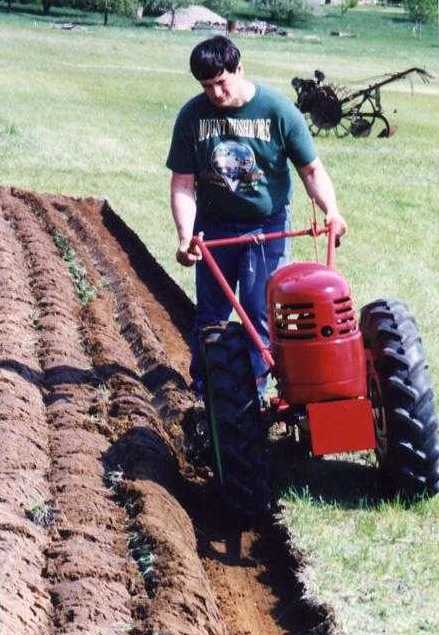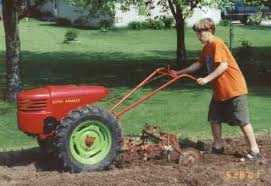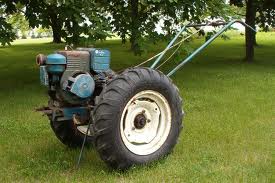Food Security with Machinery from the Past: A Walk Behind Tractor
By Guest Blogger: David B.
When our modern petrochemical food commodity production and distribution system falters from natural causes of weather, drought, disease, pests, mismanaged crop genetics or fails from a disruption of transportation, communication or power systems, or socio-economic meltdown, if we do not have a secure food supply we become a refugee.
Consider that 100 cases of pork and beans will fill up a pickup truck; you will be licking the bottom of the last can in a month if you have a dozen friends and family. Do not plan on unsustainable hunting and gathering as too major of a part of your food supply.
Consider the amount of these essential storable foods required per person per year (PPPY).
GRAINS: Wheat 200#, Corn 40#, Oats 40#, Rice 80#,
LEGUMES: Dry Beans and Peas, 66# .
To grow this list requires one half acre PPPY (based on 2002 USDA non-irrigated crop yields, reduced by 2/3 for production inefficiencies, and similar to 1950 yields). Fruits and vegetables in any form enhance the nutritional value of this diet. A laying hen will need 100 pounds of grain, and milk or meat animals require multiples of their own weight per year.
For thousands of years civilizations have thrived using draft animals in intensive agriculture. Many people advocate acquiring vintage draft farm machinery for large scale sustainable food production. With the industrial revolution came more powerful machinery allowing large scale commercial agriculture, regional marking, urbanization and loss of self sufficiency. While wartime Victory Gardens often provided 50% of the fresh food for many families, primarily because many urban populations had the skills from a rural heritage and were motivated by rationing.
70 years ago Sears Roebuck & Co. partnered with DAVID BRADLEY CO. (DB), a respected Illinois farm machinery manufacturer and marketed inexpensive walk behind garden tractors. Tens of thousands of versatile DB tractors were sold  nationwide from the famous catalog. Basically just a massive reduction transmission with auto tires and handlebars, a walk behind tractors had a rear drawbar for easily attaching actual farming implements. These included a moldboard turning and middle plows, disk and spike harrows, planters, interchangeable tool cultivators, cultipacker, hay rake, lawn roller, riding sulky, or a utility cart. Quickly interchangeable front mounting and power take off (PTO) for reel, rotary, and sickle mowers, tree and cordwood saws, dozer blades, snow throwers, compressors, orchard sprayers, and generators were also available. The belted motor pulley was used for PTO operated machinery such as grain mills, windmill pumps or a washing machine. The single cylinder 2 to 5 HP air cooled gasoline lawnmower engines were simple and reliable, repairable and replaceable. DB tractors were produced until the late 1960’s when leisure replaced personal reliance.
nationwide from the famous catalog. Basically just a massive reduction transmission with auto tires and handlebars, a walk behind tractors had a rear drawbar for easily attaching actual farming implements. These included a moldboard turning and middle plows, disk and spike harrows, planters, interchangeable tool cultivators, cultipacker, hay rake, lawn roller, riding sulky, or a utility cart. Quickly interchangeable front mounting and power take off (PTO) for reel, rotary, and sickle mowers, tree and cordwood saws, dozer blades, snow throwers, compressors, orchard sprayers, and generators were also available. The belted motor pulley was used for PTO operated machinery such as grain mills, windmill pumps or a washing machine. The single cylinder 2 to 5 HP air cooled gasoline lawnmower engines were simple and reliable, repairable and replaceable. DB tractors were produced until the late 1960’s when leisure replaced personal reliance.
With a properly equipped walk behind garden tractor you can have your Victory Garden and maintain your yard and woodlot. When you need to plant and harvest acres of grain fields or row crops on urban vacant lots or waste ground, a suburban golf course, or abandoned farm land you can do that, too. The front quick mount and PTO has been used for portable home built time saving equipment including water pumps, pressure washers, gravel or compost trommels, leaf and brush shredders, broadcast seeders, winnowing fans, and grain conveyors. Because these economical tractors use only a quart of gasoline per hour you can store a season’s worth of fuel in the tank of an unused auto, or distill corn beer into ethanol fuel. Walking tractors have also been harnessed to a mule or converted to pedal power, and recently even solar-electric powered.
While most have been sold for scrap iron, DAVID BRADLEY tractors can still be found as rural ‘yard art’, behind old barns and fence rows, online auction sites, vintage tractor club meets, or by posting ‘wanted’ ads in local newspapers and grocery markets. You can find a restored tractor plus common attachments for less than 100 cases of pork and beans, or a repairable one for $20. Disclaimer: Vintage equipment does not meet current consumer safety guidelines and requires operator vigilance and common sense.

Consider a DAVID BRADLEY walk behind tractor as one of your preparations; begin your searching, and don’t overlook a supply of heirloom seed.
Guest Blogging Author’s Bio: David B. is a retired engineer relocated from California to a rural Wisconsin homestead, utilizing expertise in a practical, sustainable lifestyle.
Related Content
- Knowledgebase
- Can You Really Depend on Local and National Government Support During Times of Disaster?
- Essential Water Purification: Navigating Chlorination, Boiling, Filtration, and Distillation
- Preparing for Domestic Terrorism and Political Violence in the U.S.
- Preparing for the Inevitable: Understanding and Mitigating the Risks of a Power Grid Collapse








And if you have traditional draft animals, start hooking them up.
My husband has a 1950s David Bradley he is trying to sell on Craigslist and no one is biting. It is so encouraging to see this article! Maybe someone will read it and find ours. Thank you!
Feel free to refer to this url in your listing…maybe it will help to encourage someone to make the move! 🙂
do you still have david Bradley garden tractor ? what model? how much$ and location? thanks
Greetings Phil.
This was a guest post on our blog by another person. Unfortunately we have not been able to get in touch with him (or Julie who posted her husband had one for sale) in quite some time.
The information is useful to be sure and we hope you find yourself a Bradley Garden Tractor of your own!
I am guessing that an ancient David Bradley with points and contact breaker would be a lot easier to repair than a more modern walking tractor if it has electronic ignition.
I ve loved the walk behind tractor which I feel can be useful at my small farm. Kindly give how much it would cost for it to reach zambia in Africa.